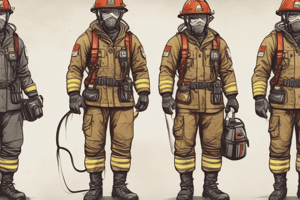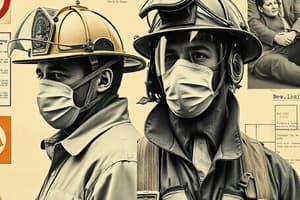Podcast
Questions and Answers
Where should contaminated bunker gear be stored after being placed in a doubled yellow plastic bag?
Where should contaminated bunker gear be stored after being placed in a doubled yellow plastic bag?
- Inside the Logistics warehouse. (correct)
- In the offices or break area of the shop/warehouse.
- In the designated biohazard red bag.
- Under the stairs in the main warehouse area.
What procedure is followed for cleaning gear contaminated with hazardous materials?
What procedure is followed for cleaning gear contaminated with hazardous materials?
- The gear is placed in a doubled yellow plastic bag and brought to the Logistics warehouse.
- A case-by-case approach is taken, involving consultation with the Pinellas County Haz-Mat Team. (correct)
- The gear is inspected for cleanliness, condition, and any necessary repairs.
- The gear is laundered at an N.F.P.A. approved laundry.
What is the schedule for inspecting personal protective clothing?
What is the schedule for inspecting personal protective clothing?
- Upon request by the Health & Safety Bureau.
- Whenever damage or repairs are needed.
- Annually, during January and February. (correct)
- Every three months.
When should protective clothing issues be reported to the Assistant Chief of Suppression?
When should protective clothing issues be reported to the Assistant Chief of Suppression?
What is the procedure for dealing with spare protective gear that does not fit properly?
What is the procedure for dealing with spare protective gear that does not fit properly?
Who is responsible for handling repair and replacement of personal protective clothing?
Who is responsible for handling repair and replacement of personal protective clothing?
What are the recommended actions for dealing with contaminated gear after hours or when the warehouse is closed?
What are the recommended actions for dealing with contaminated gear after hours or when the warehouse is closed?
What specific instructions are given regarding alterations to personal protective equipment (PPE)?
What specific instructions are given regarding alterations to personal protective equipment (PPE)?
What is the designated color of the plastic bag used to store biohazard contaminated bunker gear?
What is the designated color of the plastic bag used to store biohazard contaminated bunker gear?
What is the procedure for handling PPE when a member resigns, takes leave of absence, or retires?
What is the procedure for handling PPE when a member resigns, takes leave of absence, or retires?
What is the designated location for storing spare protective gear when it is not in use?
What is the designated location for storing spare protective gear when it is not in use?
Which of the following items are included in the annual inspection of personal protective clothing?
Which of the following items are included in the annual inspection of personal protective clothing?
What should be done with personal clothing sent for decontamination?
What should be done with personal clothing sent for decontamination?
What is the first step in the cleaning process for biohazard contaminated bunker gear?
What is the first step in the cleaning process for biohazard contaminated bunker gear?
How often should bunker pants, jackets, and helmets be sent for certification cleaning?
How often should bunker pants, jackets, and helmets be sent for certification cleaning?
What is the procedure for preparing gear for certification cleaning?
What is the procedure for preparing gear for certification cleaning?
What should you do with soiled personal protective clothing after a working fire?
What should you do with soiled personal protective clothing after a working fire?
How should you clean a helmet shell following a working fire?
How should you clean a helmet shell following a working fire?
What should you do if your gear needs repair or replacement?
What should you do if your gear needs repair or replacement?
What should you do with traffic safety vests following use?
What should you do with traffic safety vests following use?
What should you do with gloves following use?
What should you do with gloves following use?
What is the proper procedure for cleaning soiled protective clothing after a working fire?
What is the proper procedure for cleaning soiled protective clothing after a working fire?
Which of the following cleaning solutions should NEVER be used on protective clothing?
Which of the following cleaning solutions should NEVER be used on protective clothing?
Which of the following is NOT an appropriate method for cleaning a helmet shell following a working fire?
Which of the following is NOT an appropriate method for cleaning a helmet shell following a working fire?
What is the purpose of the Clearwater Fire & Rescue Department’s Standard Operating Procedure (SOP) 917?
What is the purpose of the Clearwater Fire & Rescue Department’s Standard Operating Procedure (SOP) 917?
According to SOP 917, why should firefighters ensure their protective clothing is as clean as possible?
According to SOP 917, why should firefighters ensure their protective clothing is as clean as possible?
Where should spare protective clothing be kept, according to SOP 917?
Where should spare protective clothing be kept, according to SOP 917?
According to SOP 917, what items should be removed from a firefighter's pockets before turning in their gear for cleaning?
According to SOP 917, what items should be removed from a firefighter's pockets before turning in their gear for cleaning?
According to SOP 917, when should a firefighter turn in their gear for cleaning?
According to SOP 917, when should a firefighter turn in their gear for cleaning?
What is the purpose of the “Fire Logistics” email address mentioned in SOP 917?
What is the purpose of the “Fire Logistics” email address mentioned in SOP 917?
Which of the following should be removed from the protective gear before it is bagged for cleaning?
Which of the following should be removed from the protective gear before it is bagged for cleaning?
When should a firefighter contact Logistics for cleaning their gear?
When should a firefighter contact Logistics for cleaning their gear?
Flashcards
Personal Protective Equipment (PPE)
Personal Protective Equipment (PPE)
Gear worn to minimize exposure to hazards that can cause injury.
Reporting PPE Issues
Reporting PPE Issues
Notify the on-duty Assistant Chief if PPE is faulty during off-hours.
Proper Gear Fit
Proper Gear Fit
Contact the station officer if spare gear does not fit correctly.
PPE Alterations
PPE Alterations
Signup and view all the flashcards
Returning Equipment
Returning Equipment
Signup and view all the flashcards
Annual Cleaning Requirement
Annual Cleaning Requirement
Signup and view all the flashcards
Cleaning Gear Procedure
Cleaning Gear Procedure
Signup and view all the flashcards
Packaging for Cleaning
Packaging for Cleaning
Signup and view all the flashcards
Protective Clothing Purpose
Protective Clothing Purpose
Signup and view all the flashcards
Soiled Garments Effects
Soiled Garments Effects
Signup and view all the flashcards
Storage of Spare Gear
Storage of Spare Gear
Signup and view all the flashcards
Cleaning Gear Instructions
Cleaning Gear Instructions
Signup and view all the flashcards
Spare Gear Pick Up
Spare Gear Pick Up
Signup and view all the flashcards
Laundering PPE Requests
Laundering PPE Requests
Signup and view all the flashcards
Inspection Frequency
Inspection Frequency
Signup and view all the flashcards
Manufacturer’s Specifications
Manufacturer’s Specifications
Signup and view all the flashcards
Cleaning Protective Clothing
Cleaning Protective Clothing
Signup and view all the flashcards
Avoid Dry Cleaning
Avoid Dry Cleaning
Signup and view all the flashcards
pH Limit for Cleaning Solutions
pH Limit for Cleaning Solutions
Signup and view all the flashcards
Helmet Shell Care
Helmet Shell Care
Signup and view all the flashcards
Hood Washing Method
Hood Washing Method
Signup and view all the flashcards
Boot Cleaning Guidelines
Boot Cleaning Guidelines
Signup and view all the flashcards
Glove Care Instructions
Glove Care Instructions
Signup and view all the flashcards
Handling Soiled Gear
Handling Soiled Gear
Signup and view all the flashcards
Bunker Gear Storage
Bunker Gear Storage
Signup and view all the flashcards
Contamination Policy
Contamination Policy
Signup and view all the flashcards
Biohazard Cleaning Procedure
Biohazard Cleaning Procedure
Signup and view all the flashcards
Laundry Approval
Laundry Approval
Signup and view all the flashcards
Inspection Timing
Inspection Timing
Signup and view all the flashcards
Repair Requests
Repair Requests
Signup and view all the flashcards
Annual PPE Inspection
Annual PPE Inspection
Signup and view all the flashcards
Haz-Mat Procedures
Haz-Mat Procedures
Signup and view all the flashcards
Study Notes
Protective Clothing Care Standard Operating Procedure
- Purpose: Clearwater Fire & Rescue Department provides firefighting protective clothing (bunker gear) for firefighters, inspected and maintained per departmental procedures and manufacturer's specifications.
- Soiled Gear: Soiled or contaminated protective garments are less insulating and protective than clean ones. Spare gear is kept at the Logistics warehouse, not stations.
- Cleaning Gear: Gear should be turned in for cleaning with all items removed from pockets and marked with the owner's name. Harness and straps are removed before bagging for cleaning.
- Spare Gear Return: Spare gear is returned to Logistics before pickup of cleaned gear.
- Laundered Gear: Members can request PPE gear be laundered by contacting Logistics via email for four-day turnaround.
- Bunker Coats and Pants Cleaning: Clean soiled gear on a hard surface (e.g., cement floor) with mild soap solution, warm water, a soft brush, and air dry. Avoid harsh scrubbing.
- Helmet Shells: Wash with warm water and a mild detergent, using a soft brush. Avoid liquid hydrocarbons, solvents, waxes, or polishes.
- Hoods: Use the wash container provided. Shape, dry on a towel, and do not use bleach or dryers.
- Boots Cleaning: Wash boots with warm water, mild detergent, and a soft brush. Do not use liquid hydrocarbons, solvents, waxes, or polishes. Disinfect the inside of the footwear.
- Gloves Cleaning: Machine wash warm, drip dry, and do not bleach.
- Traffic Safety Vests: Machine wash cold with mild detergent, tumble dry on low, or hang dry. Do not bleach, iron, or dry clean.
- Soiled/Damaged Gear: If gear is extremely soiled or needs repair, contact Logistics. Personnel will issue replacement gear. Personnel should put the soiled gear in a clear plastic bag and bring it to Logistics.
- Biohazard Gear Cleaning: Soiled biohazard-contaminated bunker gear should be placed in a double yellow plastic bag, marked with the owner’s name, shift, and station. Do not place in a biohazard red bag.
- Haz-Mat Gear: Hazardous materials contamination cases are handled on a case-by-case basis, using the Pinellas County Haz-Mat Team.
- Annual Inspection: In January and February, all personal protective clothing is inspected for cleanliness, condition, and necessary repairs. The inspections combine with SCBA fit testing, and emergency procedure review
- Personal Protective Gear Repair/Replacement: Direct contact Logistics for replacement or repairs via email or phone.
- Gear Handling: Contaminated gear is not allowed inside the office or break areas.
- Gear Preparation for Cleaning: Gear is prepared similar to other cleaning. All pockets' items are to be removed and marked. Harness and straps are to be removed before bagging.
- Cleaning Packaging: Gear is to be placed in a clear bag with the name clearly marked for cleaning. (Unless contaminated)
Studying That Suits You
Use AI to generate personalized quizzes and flashcards to suit your learning preferences.




